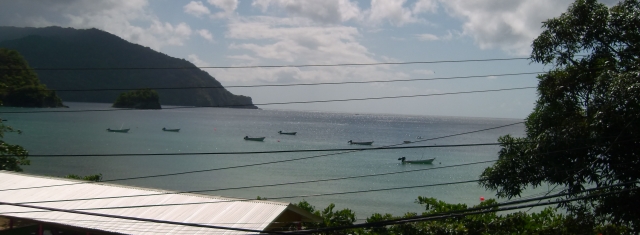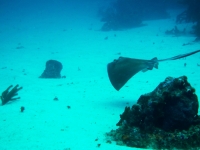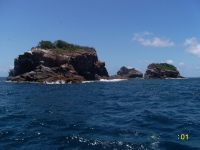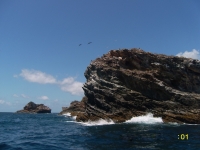Sports
Dive Tobago
Dive report for the island of Tobago

Spreyside (Source: John Miller)
USPA NEWS -
A little hidden jewel where Manta Rays and fast drift diving are top draws to this little island. Nobody goes to Tobago for the nightlife. The island is so laid-back and relaxed that most people are in bed by 10:30pm. A local idiom says "get up with the sun, go to bed with the sun." We went there to take under water photos and hopefully to see the mantas and wow did we!
On Monday I settled into Blackjack Hole with others and snapped frame after frame of coral, sponges and marine life of all sizes away from the strong currents. It was while taking a leisure drift along the coral at Spiney Column one afternoon that we all looked up to see a hovering space craft above us ““ no it was the elusive manta that we came to Tobago to see and my battery was dead! Book Ends was a thrill with surge breaking on the rocks and reef above us, a great wall, and I deliberately added more weights to stay low in the current around 70 feet. As a private pilot I´ve had some wild rides, but “surfing“ these currents over the reefs was such a thrill that I had to put the camera away and just enjoy the ride.
On Monday I settled into Blackjack Hole with others and snapped frame after frame of coral, sponges and marine life of all sizes away from the strong currents. It was while taking a leisure drift along the coral at Spiney Column one afternoon that we all looked up to see a hovering space craft above us ““ no it was the elusive manta that we came to Tobago to see and my battery was dead! Book Ends was a thrill with surge breaking on the rocks and reef above us, a great wall, and I deliberately added more weights to stay low in the current around 70 feet. As a private pilot I´ve had some wild rides, but “surfing“ these currents over the reefs was such a thrill that I had to put the camera away and just enjoy the ride.
In a good economy, most people will dive where the adventure gives them a reasonable return on their vacation dollars. When money is tight, we become far more selective, choosing to stay closer to home or go to places we can reach with inexpensive air fare. Therefore, we read the dive magazines, search the web, and check out Undercurrent.org for the latest reviews. Trinidad-Tobago just doesn´t make most people´s top ten list, and the limited reports I saw were not very favorable - so I wondered why would PADI Sport Diver magazine pick this place for one of their special group tours? Would it be worth the money to put it on my list of dive locations this year? In March my wife and I had a great stay at Turneffe Island Resort in Belize and plan on going back again. But we were searching for our summer trip and the list of possibilities reflected Little Cayman, BVI, Bonaire, Bahamas, and Curacao ““ all popular sites that get great referrals from the Sport Diver community.
This 61 year old PADI Master Diver and his recently certified PADI Advance Diver, 60 year old wife of 41 years, decided to check it out. We decided to sign up for the Sport Diver Mantas and Full Moon tour that was being held the first week in June and see for ourselves. I justified the trip because of the opportunity to dive with some experienced underwater photographers and improve my own camera skills. I had also heard this is a forgotten diving location with rich coral and sea life, so what the heck ““ let´s go check it out.
Tobago is located just south of the hurricane belt off the coast of Venezuela, so it is usually outside the path of this summertime threat to travel plans. Trinidad-Tobago are completely different islands, much like Grand Cayman and Little Cayman are. While Trinidad is large, industrial and sweaty; Tobago is a tiny, postcard pretty, quiet, and warm with fresh trade winds (average temperature 30C (86F) island. To put it in perspective, Trinidadians holiday in Tobago and this West Texan figured the “cooler“ weather would be nice. You will find air conditioning and fans in most locations for comfort. But it is still very humid, thus the rain forest!
Tobago´s peak season is January ““ May as that is their “˜dry season´. It is cooler (just 80F!) and rains little and for that reason, it is the most expensive time to visit. Low season is June- December and is the so called “˜wet season´ - not to be confused with “˜monsoons´ folks, and yes it did rain on us ““ but not for very long. The island is at its most beautiful in this season as everything is full of color.
The local currency is the Trinidad & Tobago dollar (ttd´s), and the exchange is roughly $0.16 for 1 TT$ at the time of this writing. What do you get for your money? Well, a bottle of the local beer, Carib, costs about 8 TT dollars ($1.27) at most beach or local bars. A local take-away dish - “˜roti´ - can be had for no more than 8 TT dollars and comes with chicken, beef, shrimp or goat and is delicious.
A lot of hotels and guesthouses are in the Crown Point area and near to the airport. Scarbough is just up the coast from the airport (on the way to Speyside). Our group was staying even further up the coast at Speyside, the place I would most recommend for all experienced divers to head for.
Dress casual and for coolness with some good insect barrier protection. If you´re staying in one of the top hotels then you may want to pack a few posh frocks or shirt and tie but generally shorts and T- shirts are the norm. Speyside is predominantly known on Tobago for its diving opportunities and the reason for our staying there. Because of its currents it is also a dive area for the Intermediate to Master experienced level diver ““ so be sure to check with your dive operator and be in good shape. The diving is simply fantastic, and it´s here that you´re likely to see the island´s famous manta rays. From Speyside you can almost throw a stone to Goat Island with Little Tobago, a 450 acre bird sanctuary, just beyond. We spent some top-side time on Little Tobago taking photos of the birds to decompress a little. What a climb and I was the last one to the top!
Tobago is a nature lover´s toe tingling paradise. No other island can boast such diverse and abundant wildlife - thanks to the fact that Tobago was once part of South America. This tiny island of only 26 miles by 7, has hundreds of species of birds, plants, flowers and wildlife; has the oldest protected rainforest in the Western Hemisphere; is surrounded by healthy coral reefs; has superb and varied scuba diving; has undeveloped and unspoiled beaches; and the world´s largest brain coral. It also enjoys the coastal contrasts of the Atlantic Ocean on one side of the island, and the Caribbean Sea on the other. So you have it all, and can probably do it all in at least a week, but stay longer if you can.
After traveling all day we unpacked Saturday night around 11:30 p.m. at our lodge and went straight to bed. We woke up Sunday to a fantastic breakfast buffet prepared for us next to the pool and then strolled over to the dive shop just down the walk beyond the pool to check out our gear and put it in baskets to be loaded by the staff for the ride over to the dock. The pool was a great place to test equipment prior to the first dive of the week to be sure everything was operational.
Unloading at the dock, putting our gear together and putting on some thin protection - we were anxious to get wet. Ty Sawyer and his compact light-weight camera are ready to go diving and Goat Island with Little Tobago are in the background. These will be our sites for the majority of our diving activities. With the docks so close to our dive sites we returned to them after each dive to rinse off and get fresh tanks of air and check photos.
Unloading at the dock, putting our gear together and putting on some thin protection - we were anxious to get wet. Ty Sawyer and his compact light-weight camera are ready to go diving and Goat Island with Little Tobago are in the background. These will be our sites for the majority of our diving activities. With the docks so close to our dive sites we returned to them after each dive to rinse off and get fresh tanks of air and check photos.
Book Ends, Japanese Gardens, Blackjack Hole, Cathedral and Spiney Column are the best dive sites - with Books Ends and Blackack Hole being my favorites. My first dive on Sunday was to Cathedral and I dropped down the wall to 103 feet to drift along and snap my first shots. After swapping tanks at the dock it was back out for the second dive of the morning to Japanese Gardens and a more shallow dive to 83 feet and make the ride around the corner of Goat Island as the current swept us along the coral reef. Japense Gardens is a photographers dream come true and I was glad I was no longer restrained to how many pictures I could get on a roll of film, just praying my batteries would hold out longer than my air.
On Monday I settled into Blackjack Hole with others and snapped frame after frame of coral, sponges and marine life of all sizes away from the strong currents. It was while taking a leisure drift along the coral at Spiney Column one afternoon that we all looked up to see a hovering space craft above us ““ no it was the elusive manta that we came to Tobago to see and my battery was dead! Book Ends was a thrill with surge breaking on the rocks and reef above us, a great wall, and I deliberately added more weights to stay low in the current around 70 feet. As a private pilot I´ve had some wild rides, but “surfing“ this current over the reefs was such a thrill that I had to put the camera away and just enjoy the ride. It takes a little work to stay with your buddy, as miss judge the current and they´ll go one way while you go another. Sort of reminding me of that movie where the ore car of people go one way while the other car disappears down some other track. I spent some time on the surface with my sauguage blowing my air horn to get the boats attention and get picked up, but what a thrill!
Monday evening we were treated to a beach barbeque by our guests, complete with island entertainment. On Tuesday we were off to our morning dives, back rolling off the boats on the count of three and going to the bottom as quickly as safety in equalizing would permit. The currents are swift and getting the entire group to the bottom quickly helps keep us from spreading out along the reef to the point that the dive master can´t oversee the group. But our guys are professionals with one up current and one down current like sheep herders, keeping an ever watchful eye on us ““ though we´d love for a few wolves (sharks) to show up.
The dive masters have a hard task as safety divers for our group. Their tasks is made even more difficult by everyone with cameras stopping for 10-15 minutes at a time, taking frame after frame, changing f=stops and shooting even more frames, waiting for everyone to line up in the frame for that shot of a lifetime and then snapping a few more frames before moving on for the next perfect shot. The use of diffusers was a must due to all the fry in the water that reflect your strobes lights. But it is this very fry that bring the mantas to Speyside.
The dive masters have a hard task as safety divers for our group. Their tasks is made even more difficult by everyone with cameras stopping for 10-15 minutes at a time, taking frame after frame, changing f=stops and shooting even more frames, waiting for everyone to line up in the frame for that shot of a lifetime and then snapping a few more frames before moving on for the next perfect shot. The use of diffusers was a must due to all the fry in the water that reflect your strobes lights. But it is this very fry that bring the mantas to Speyside.
For a photographer that came to Tobago to capture the manta and hammerheads on film, that hardest decision each dive is whether to outfit your camera for macro or wide angle zoom lenses. However, t
The only zoom you should use is your fins. Get as close to your subject as you can, take your time and become one with your subject. Let them get to know you and accept your presence and then get closer before taking the picture.
My wife back rolled off the boat one day, only to descend in a swarm of bubbles as her computer transmitter had been loosened in handling on the boar and was severely leaking air. The alert dive master came to her assistance before I could and safely got her back on the boat, tighten the transmitter, got her a fresh tank and back in the water.
Our last day of diving was across the island on the Caribbean side of Tobago at Twin Sisters and hopefully capturing some hammerheads on film. Though we couldn´t find any hammerheads, we all agreed this was another great dive site. Long after everyone was in the boat, Ty Sawyer and Michael Pitts were down below draining the last PSIs of air out of their tanks - trying to capture that last minute chance to get the elusive photo, as we all scanned the horizon for their floats or bobbing heads.
Our last day was spent resting and decompressing in preparation for the evening departure celebration with the Trinidad-Tobago Tourism Department and their planned entertainment, along with slide show by Ty and Michael with awards for best picture.
To answer my initial question, yes it was worth putting Tobago on my must dive list and all of the reports I had read in preparation for this trip were simply wrong or those divers had not been to Speyside. Blue Moon and Manta Ray were professional dive operations and their resorts provided good food, relaxation, and were wonderful hosts for our demanding group. All of these photos were taken with my Sea & Sea H1200 with wide angle lens and strobe package. It´s a great point and shoot, in and out of the water, but after this trip I was ready to move to a SLR. I´ve chosen the new Nikon D5000 with 10-24 wide angle lens an Ikelite housing with sub strobe. I´ll take along my Sea & Sea as a backup on my next dive trip. I look forward to another opportunity to dive with Ty Sawyer and Michael Pitts to glean more photography and dive tricks from these two great professionals and am now happy to call them friends.
LTC John E. Miller, USA (Retired)
PADI Master Diver, Lubbock TX
Liability for this article lies with the author, who also holds the copyright. Editorial content from USPA may be quoted on other websites as long as the quote comprises no more than 5% of the entire text, is marked as such and the source is named (via hyperlink).









